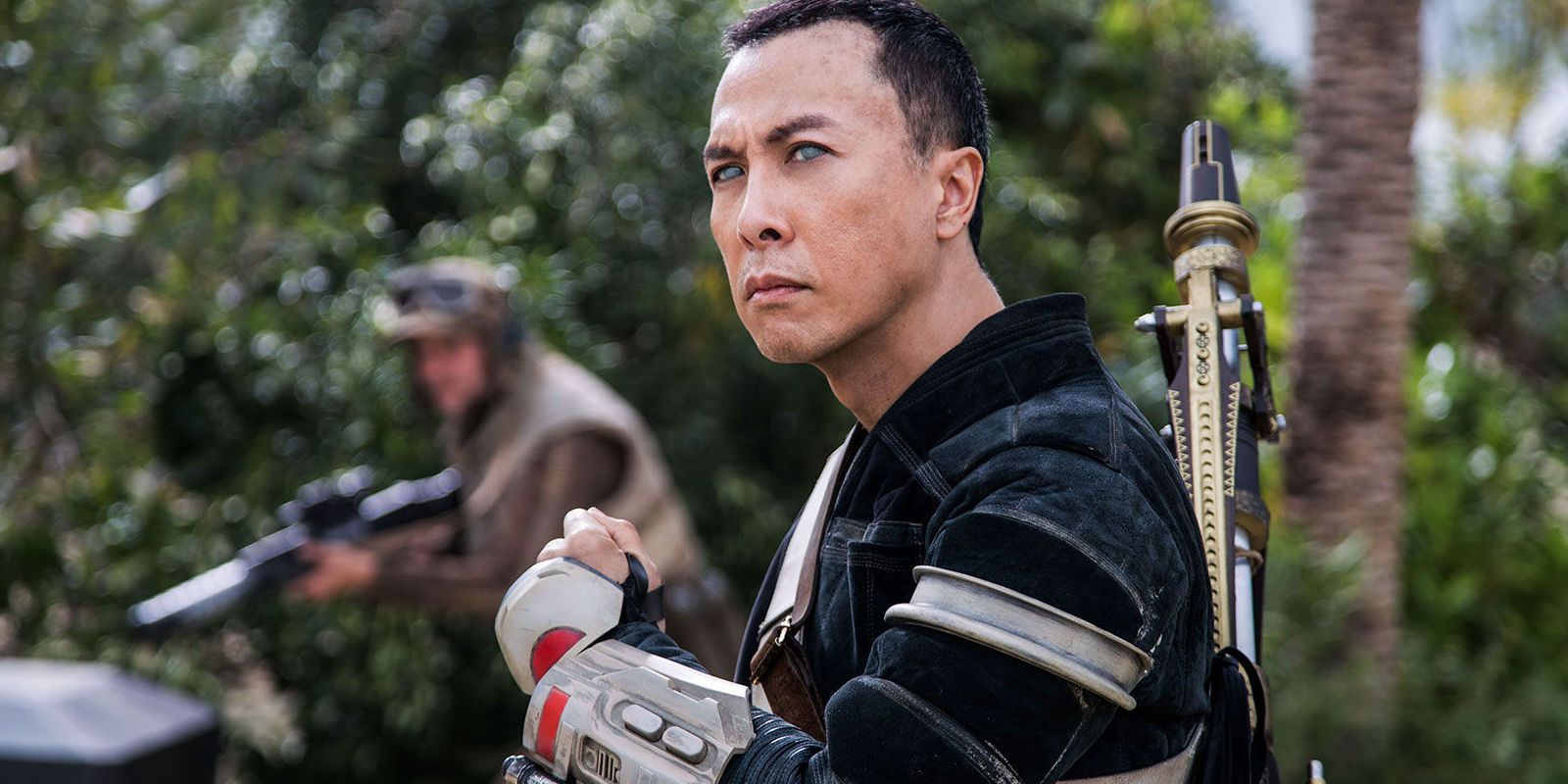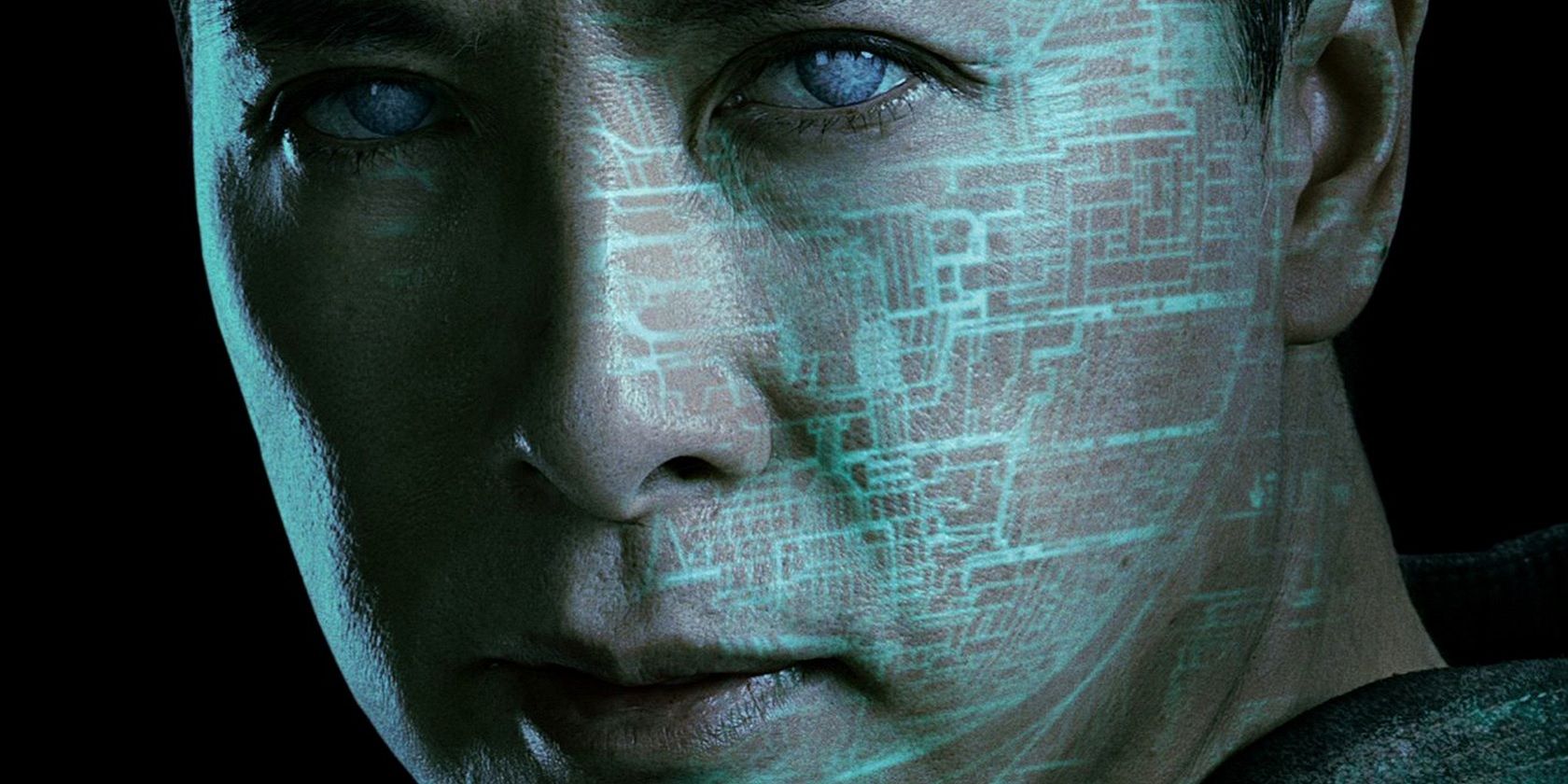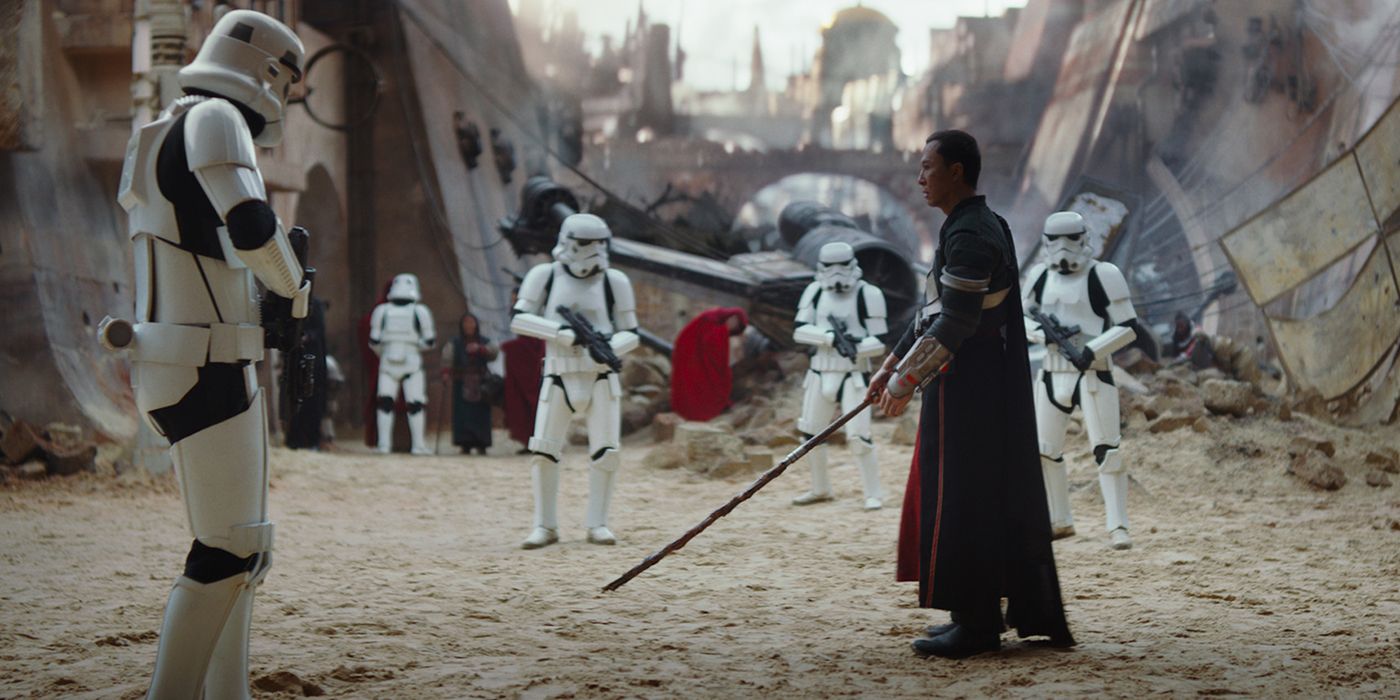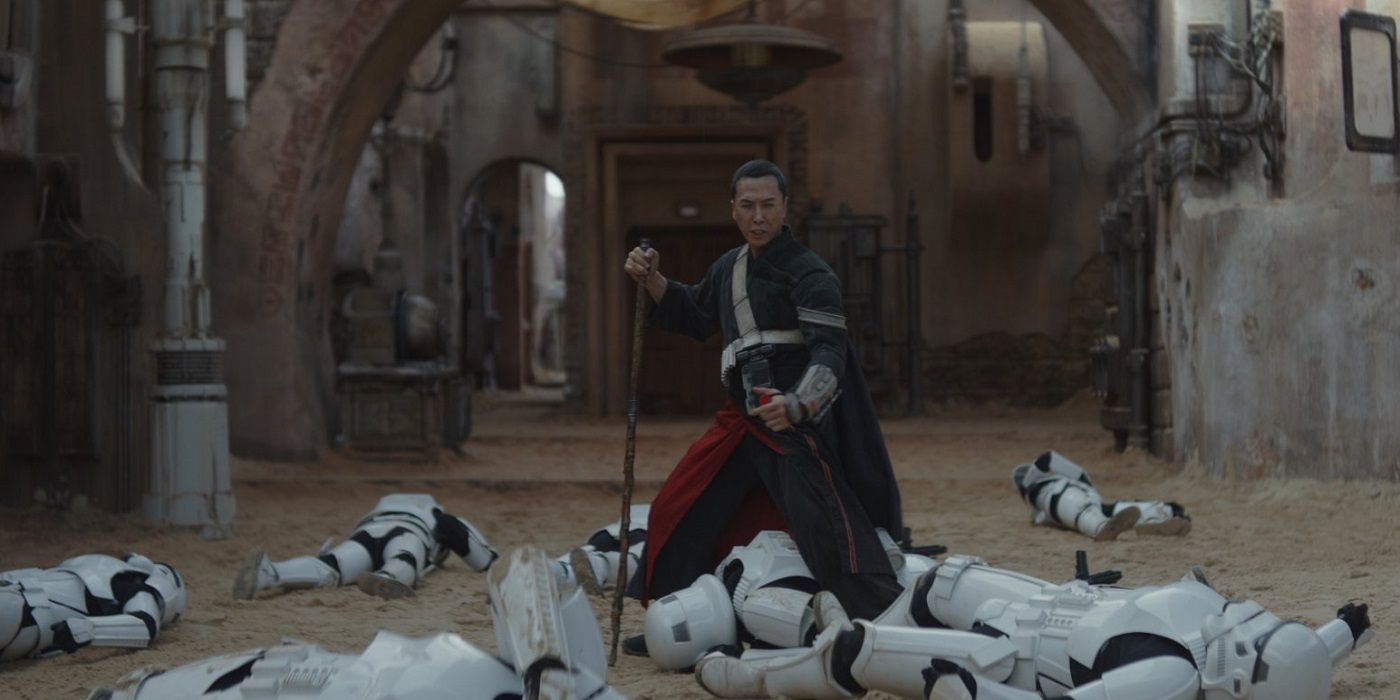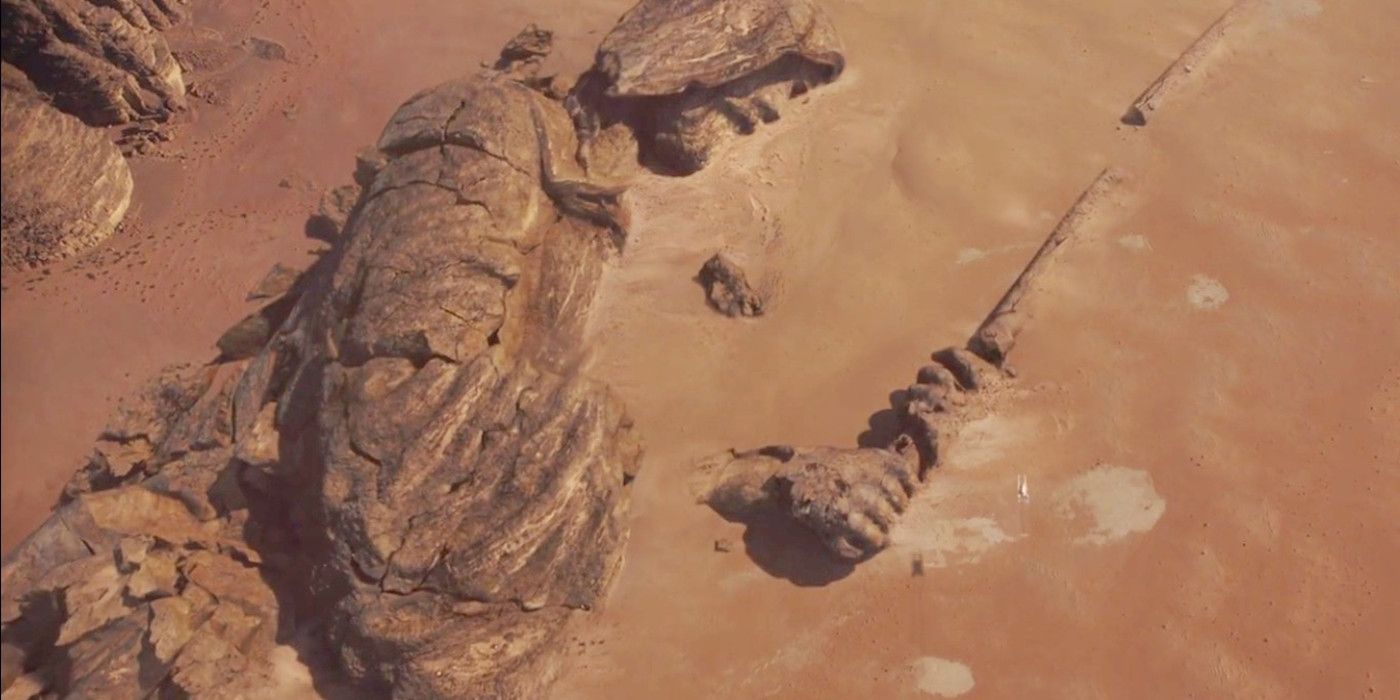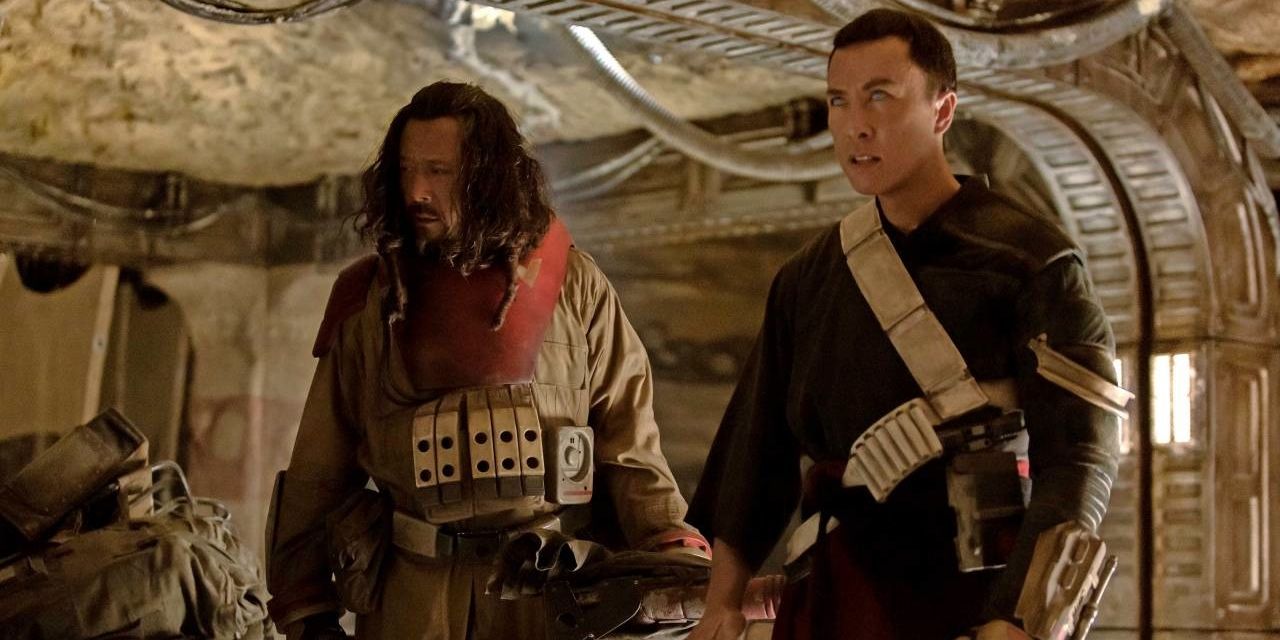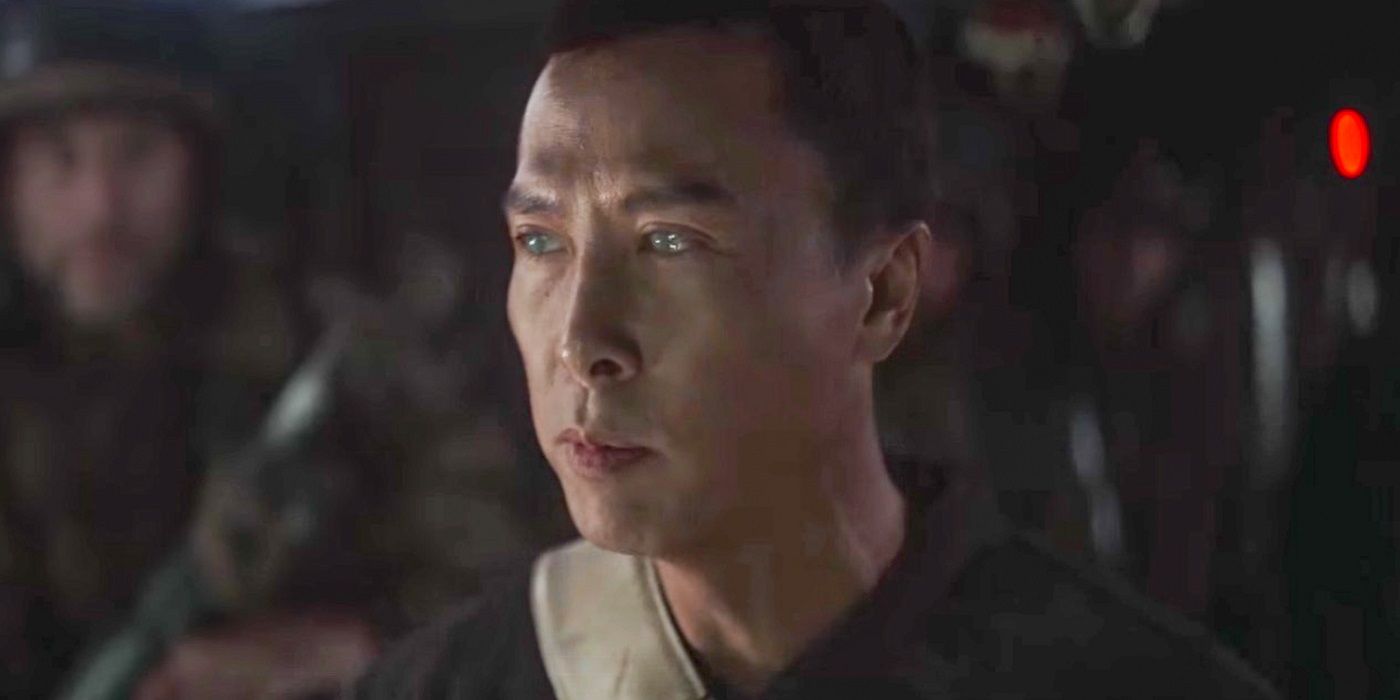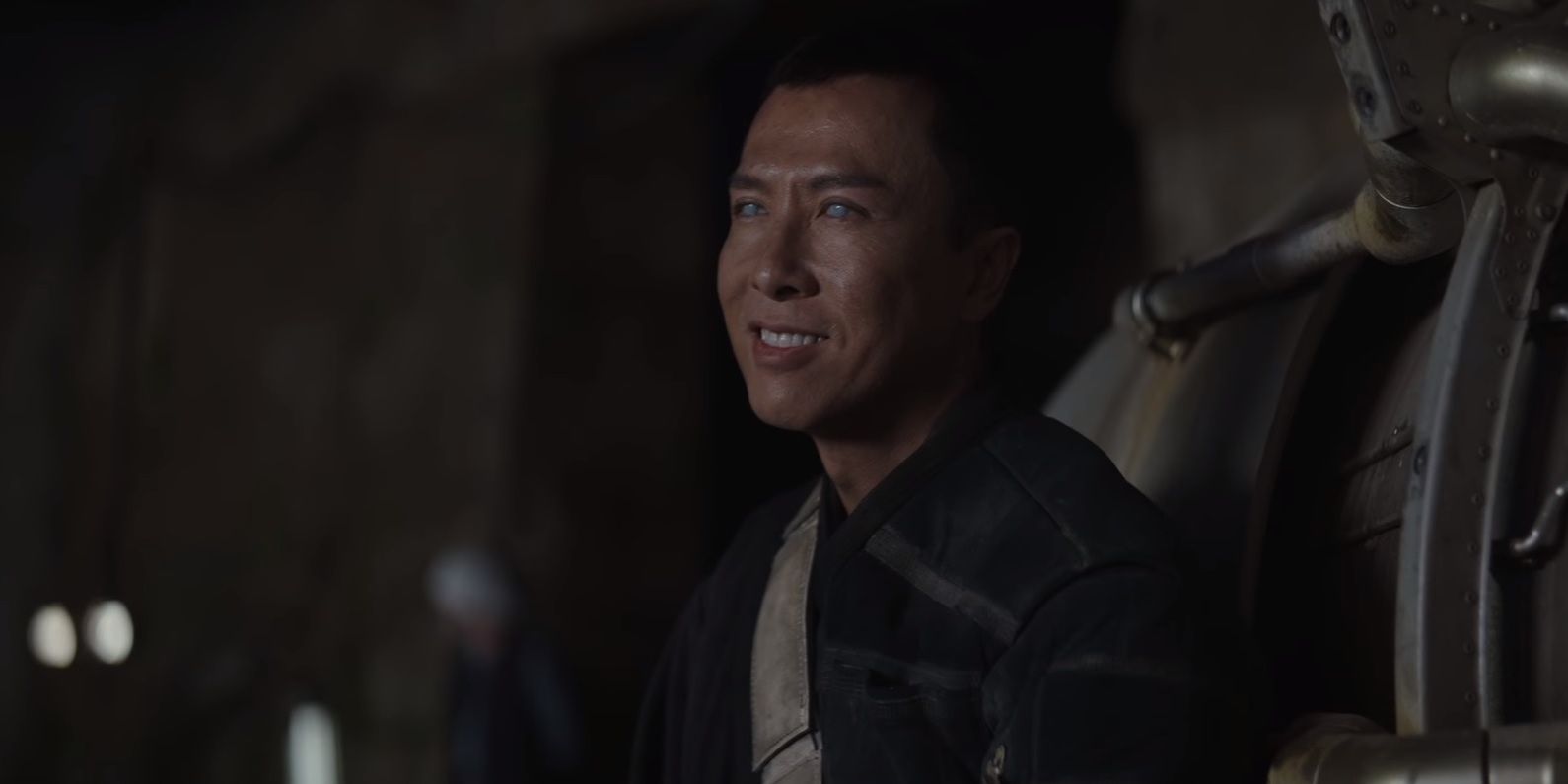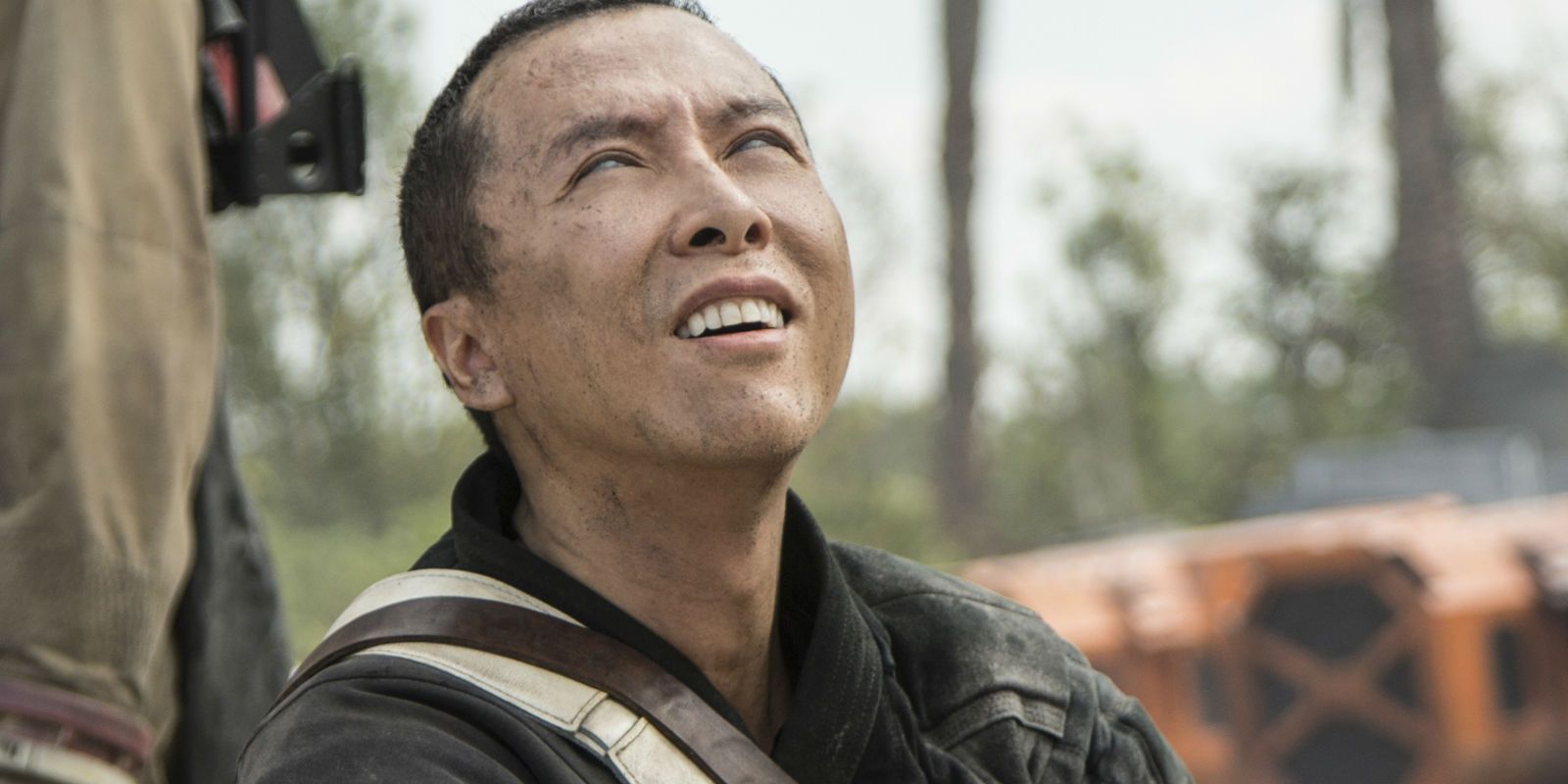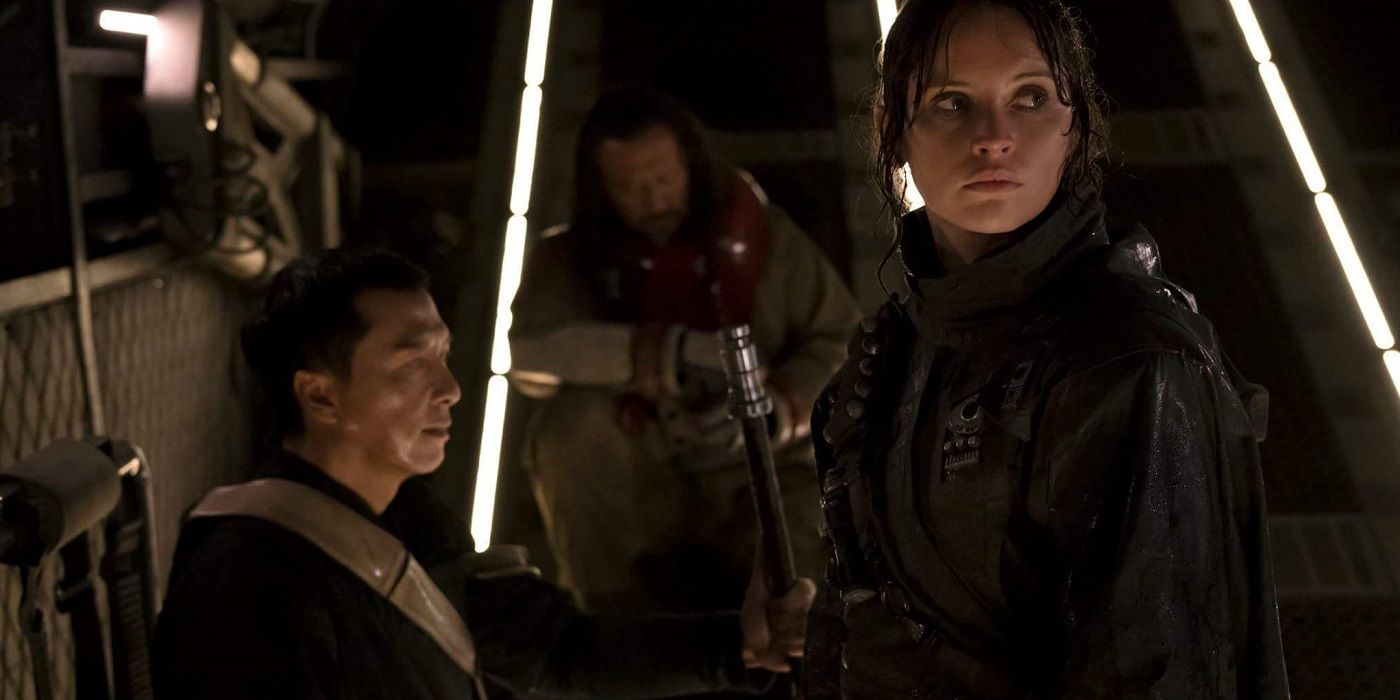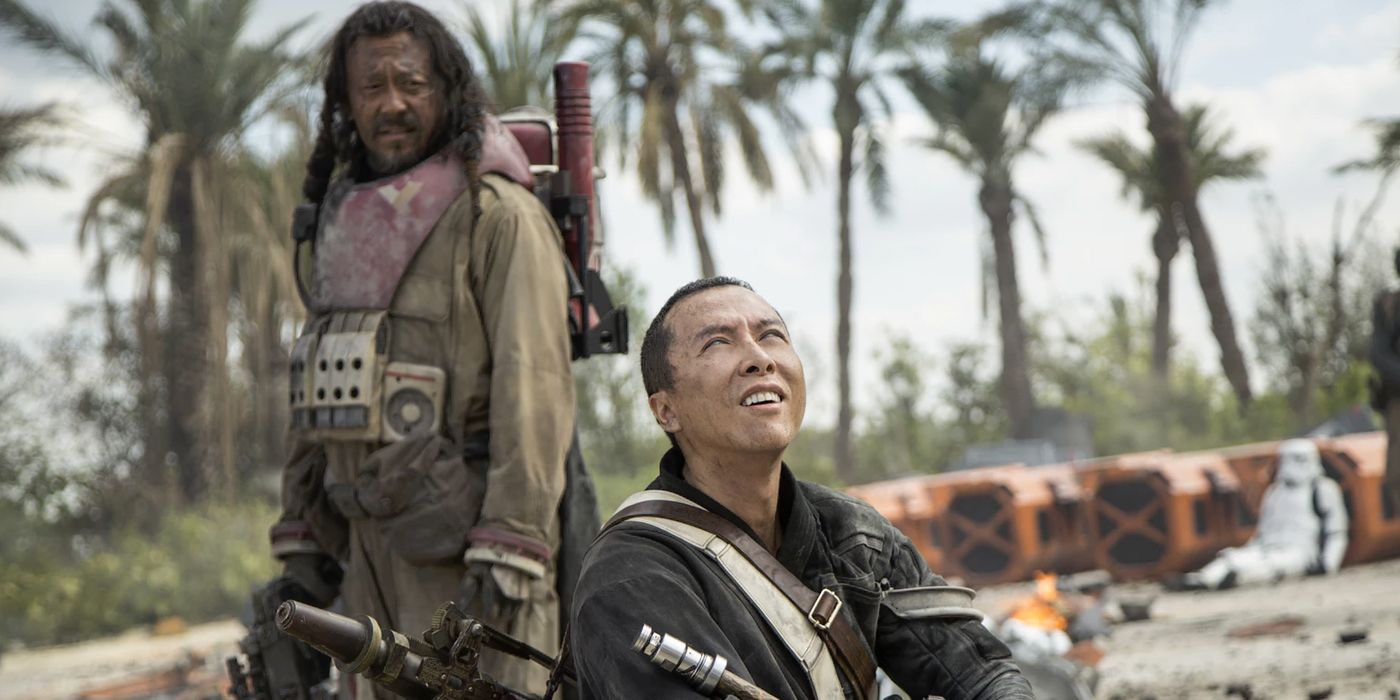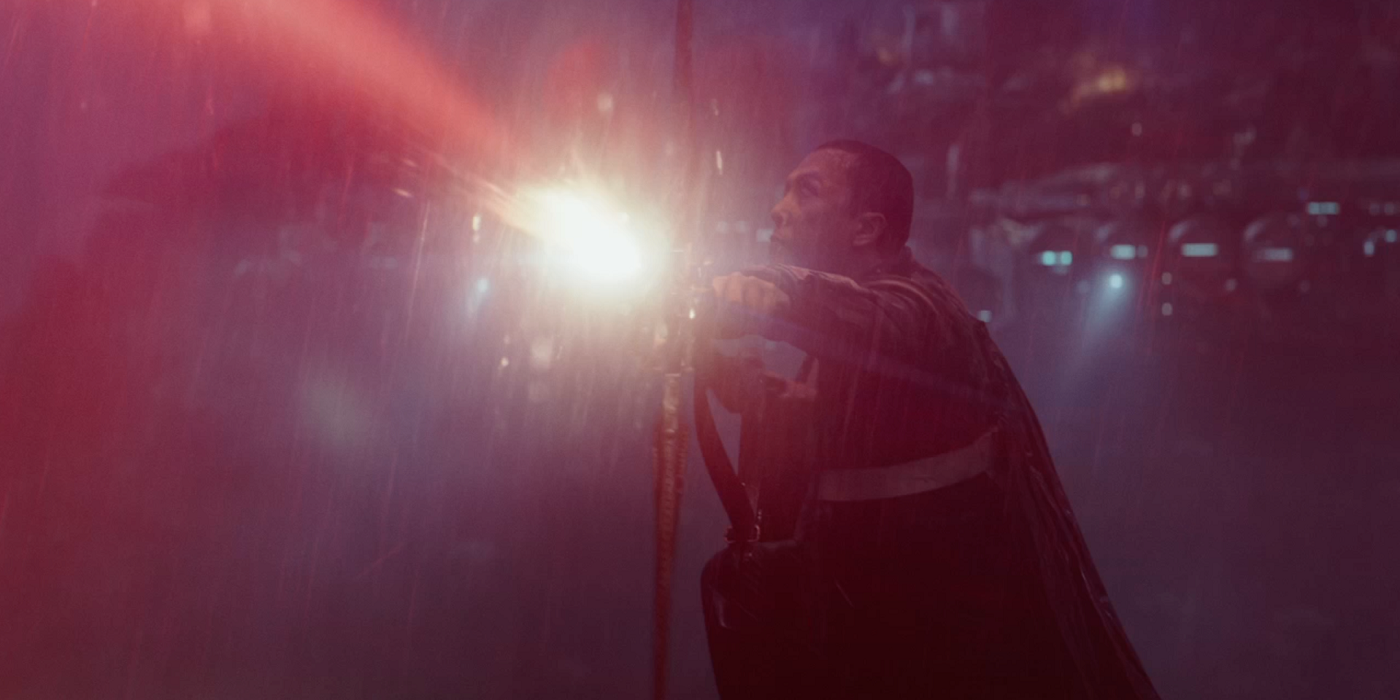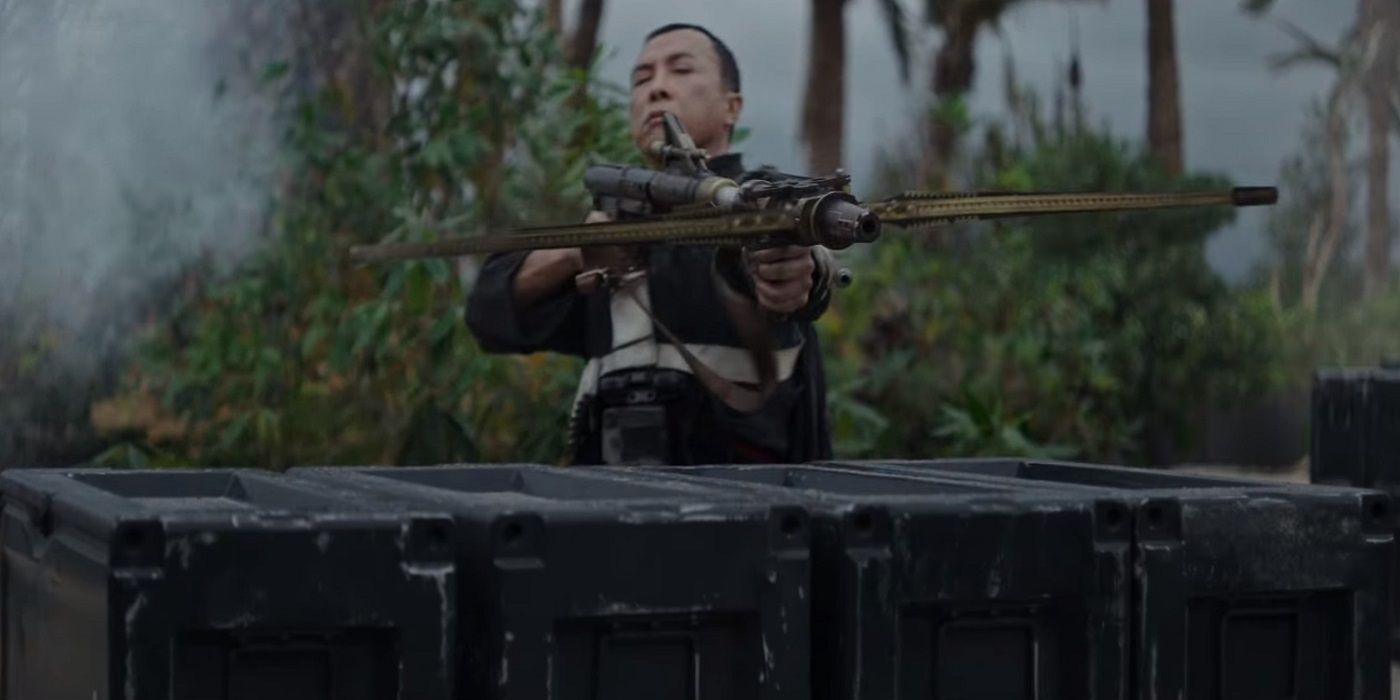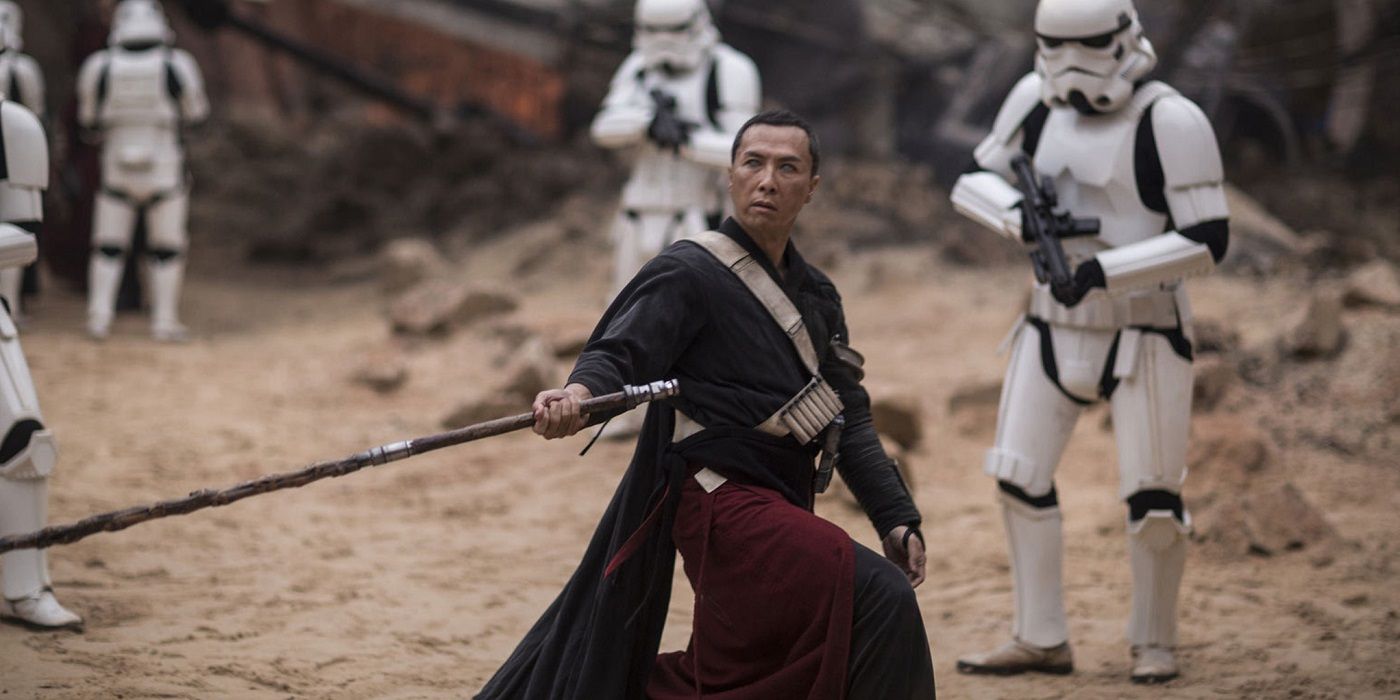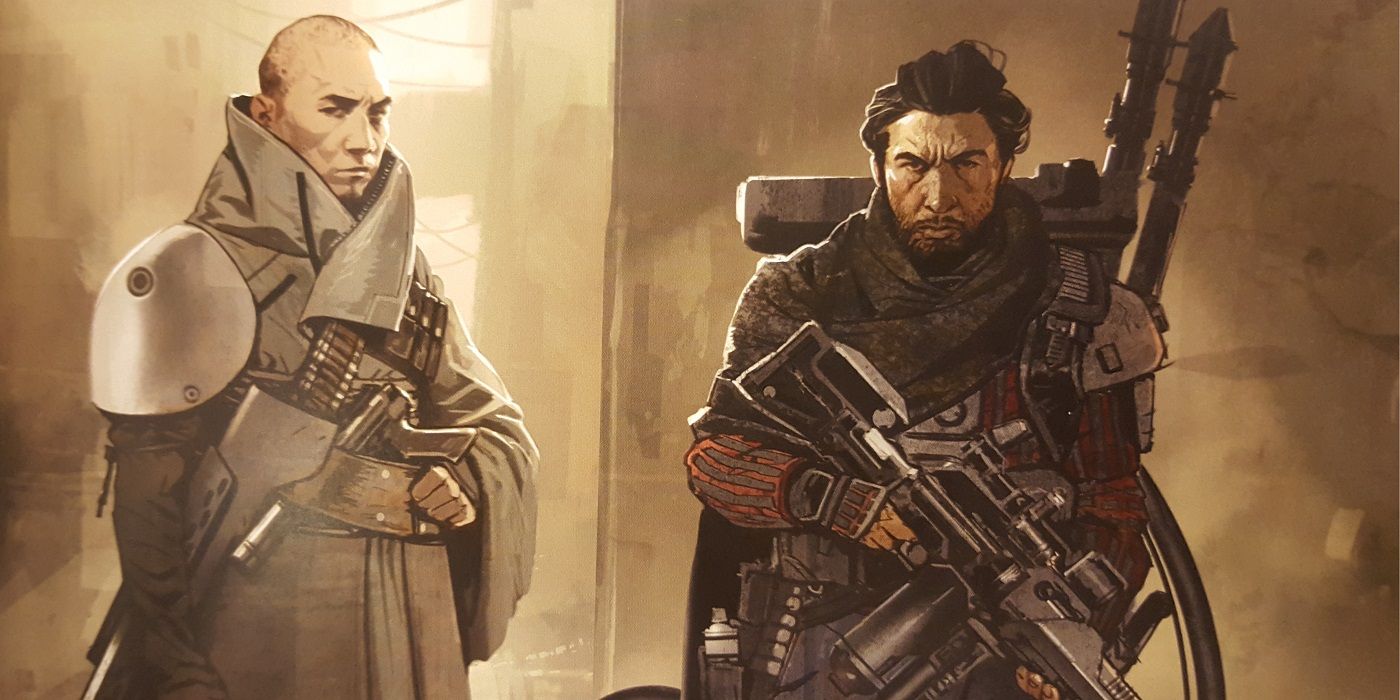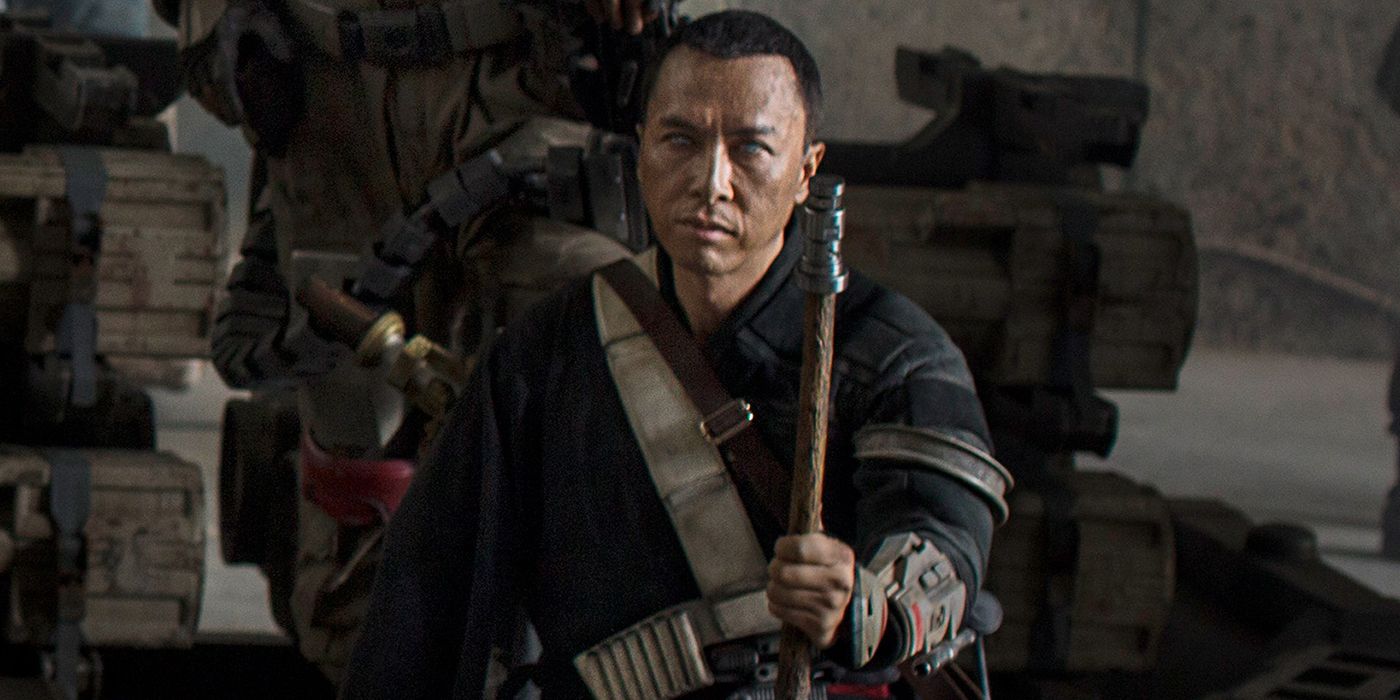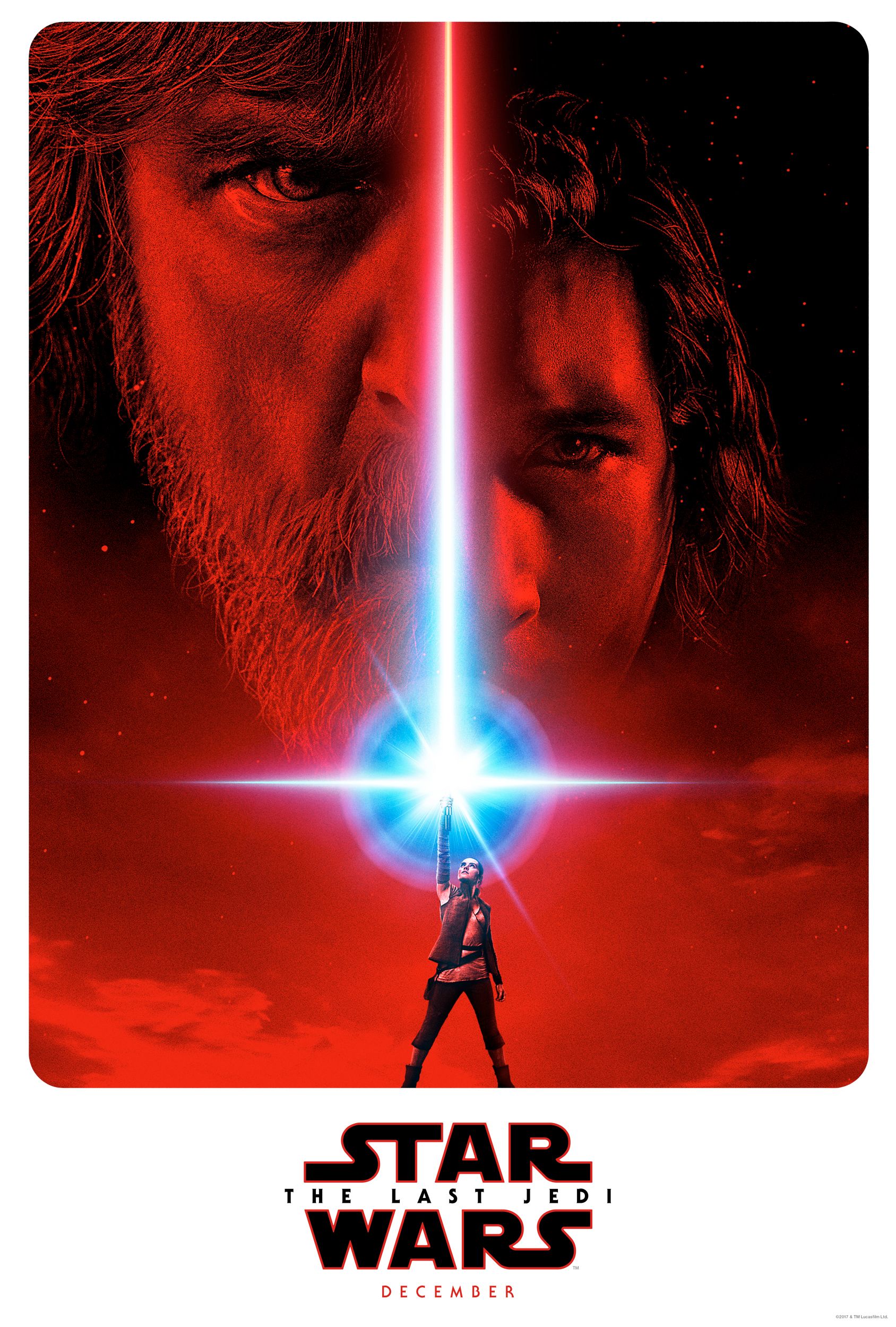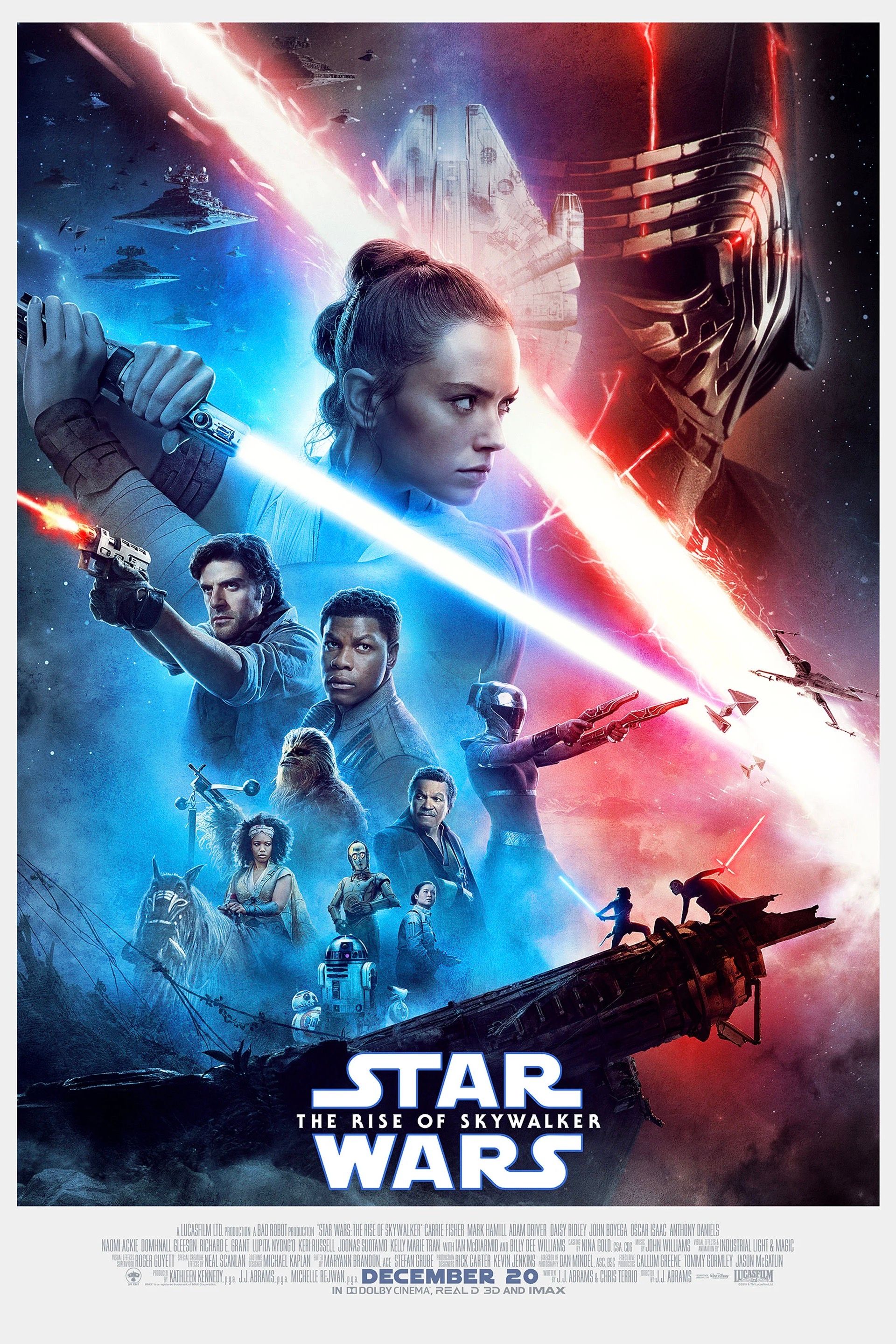Esteemed actor Donnie Yen has captivated audiences with his performance as the devoted Chirrut Îmwe, one of the most enigmatic characters in Rogue One: A Star Wars Story.
Martial arts enthusiasts and Star Wars fans alike rejoiced upon hearing that Yen would be heading to a galaxy, far, far, away in Rogue One: A Star Wars Story. Yen brought Chirrut Îmwe to life, acting as a spiritual anchor for the motley group of rebels in the film.
As with many other characters in the Star Wars universe, his name carries special significance. While the name “Chirrut” seems to be purely fictional, the word “chi” could be a nod to the martial art form of t’ai chi chuan. Given that Donnie Yen’s mother has extensive expertise in martial arts, this reference makes sense. Yen’s mother is none other than Grandmaster Bow Sim Mark, who has studied t’ai chi chuan, traditional kung fu, and wushu for decades. The word “imwe” translates as the word “one” in the language spoken by the Kikuyu people of Kenya. Guided by his faith, the warrior monk is strongly attuned to the Force and led by his moral compass.
Warning: Spoilers ahead for Rogue One.
Here are 15 Things You Didn’t Know About Chirrut Îmwe.
15. He is Force-Attuned, Not a Jedi
In the film, Chirrut dodges blaster bolts with lightning fast reflexes, sweep kicks Stormtroopers, and performs impressive stunts that make viewers do a double-take. Based on these things alone, many viewers might assume that Chirrut is a Jedi, or possibly a former Padawan. In the novelization, Jyn feels clumsy after witnessing his graceful and effortless fighting style. After Chirrut wrecks a dozen Stormtroopers on his own, Cassian asks Baze cautiously, “Is he a Jedi?”, to which he replies, “No Jedi anymore. Only dreamers like this fool.”
Although some fans might write this off as common knowledge, we had to include this one right off the bat, just to clear up any confusion—Chirrut is not a Jedi. (We repeat, Chirrut is not... a... Jedi.) That being said, he certainly has become a beloved favorite by many after watching the film. According to Rogue One: The Ultimate Visual Guide, written by Pablo Hidalgo, "Though he seemingly lacks Force abilities, this warrior monk has vigorously honed his body through physical and mental discipline.”
For a better understanding, Chirrut a perfect example of a devoted disciple, spending years training his body, mind, and spirit. His character shows that there is way more to the Force in the new canon than what was previously assumed. The introduction of characters like Chirrut Îmwe and Baze Malbus allow fans to explore the great dichotomy between the Jedi, the Sith, and the gray area in between.
14. Practitioner of zama-shiwo, a Jedha martial art
Although we’re not given any background information in the film, the Rogue One novelization and an assortment of related books have given us snippetsof Chirrut’s backstory. In the Rogue One novelization penned by Alexander Freed, the author gives us a clue during Chirrut’s last stand. There’s a line regarding Chirrut’s connection to the art of zama-shiwo, defined as “the inward eye of the outward hand.”
In Rogue One: The Ultimate Visual Guide, there are even more tidbits of information about the mysterious art form. “The central pillar of zama-shiwo involves perfection of physical awareness—conscious accounting of a body’s placement, contact and internal functions. It is said that a master of these techniques can alter his heart rate, oxygen intake, and vital processes to produce seemingly supernatural effects. This is similar to Jedi physical exercises that emphasize bodily control—some believe due to a cultural connection with the ancient past.” In the Rogue One: Secret Mission book targeted at kids, zama-shiwo “Allows him to use his senses to read his environment.” Based on what we know, it seems like zama-shiwo is akin to t’ai chi chuan, ninjitsu, yoga, and meditation.
Our very own Rob Keyes had the pleasure of interviewing Donnie Yen leading up to the film, but when pressed about Chirrut’s backstory, Yen wasn’t allowed to elaborate. We hope to learn more about his mysterious background and find out more information about zama-shiwo in upcoming Star Wars films, books, and various media.
13. Served as a Guardian of the Whills, Protector of the Temple of the Kyber
For those in need of a quick refresher, Chirrut Îmwe and Baze Malbus formerly served as Guardians of the Whills. Described as a near-extinct order, Îmwe and Malbus were sworn to protect the Temple of the Kyber located in the Holy City of Jedha. In Rogue One: The Ultimate Visual Guide, fans are given a small clue about the Guardians. “An ancient order, its origins are lost to time and inextricably woven into the legends of the Jedi Knights. Some believers insist the Jedi drew inspiration from the followers of Jedha, while historians surmise it is likely the opposite. Whatever the truth, it is all a matter of deepest faith to Chirrut.” In the film, Cassian gets Jyn up to speed by telling her that since the temple was destroyed by the Empire, the Guardians no longer have anything to protect.
The word “Whills” might sound familiar, because it was part of an original concept by George Lucas. He had originally envisioned for the original Star Wars films to be excerpts from the journal of the Whills, but it never saw the light of day. The “Whills” were referenced in the original script, and were considered to be introduced in The Clone Wars, as the ones who instructed Qui-Gon Jinn on how to communicate through the Force after his death. Based on what we know so far about Chirrut and the Guardians of the Whills, it seems like we’ll be getting even more information about them in future work.
12. Chirrut was Baze’s father figure in earlier drafts
In the film, Chirrut and Baze have a unique dynamic, almost acting as the polar opposites of one another. However, in earlier drafts of the script, Chirrut was actually written as a father figure to Baze Malbus. According to The Art of Rogue One, “I [initially] arrived at this notion that Chirrut was kind of like Baze’s father/confessor in a very ‘the Force’ kind of way. So Baze was able to lay his guilt onto Chirrut, even though he didn’t believe in the Force, and Chirrut could believe in Baze’s eventual redemption. I think that there’s humor there, in these two characters who really seem completely at odds with one another but are tied together.”
Although the most of the idea was scrapped, viewers are able to get a sense of the redemption theme in the final arc of the film. While imprisoned by Saw Gerrera, Chirrut comments that Baze Malbus used to be the most devoted Guardian of them all. The two share some amusing back and forth banter on screen, with Chirrut relying on his deep rooted faith, while Baze prefers a more pragmatic approach with his killer machine gun. In the novelization, Chirrut’s chanting seems to guide his motions as he takes his last stand on Scarif. His final scene is particularly poignant, and when Baze heartbreakingly echoes Chirrut’s mantra of “I am one with the Force, and the Force is with me.” It seems to captures the sense of redemption perfectly.
11. The hardest part of the role was wearing the contact lenses
Part of what makes Chirrut Imwe so appealing is his grounded, Zen-like persona. In Art of Rogue One, the artists revealed that they had initially played around with different ideas regarding his eyes. Some pushed for the idea of creating an effect similar to actual cataracts, but eventually settled for the haunting contact lenses used in the film.
While making the film, one might assume that the serious stunt work and martial arts sequences would be particularly challenging. But naturally, for a seasoned vet like Yen, it was actually the opposite. Yen said that wearing the contact lenses was one of the hardest parts of the role. When filming, he had to remove the lenses every two hours and give his eyes a rest for at least twenty minutes in between each session. Even when the contacts were removed, the blurriness would still affect his vision.
“It was harder than if I couldn’t see,” he said to South China Morning Post. “If I couldn’t see, naturally I would convey the state of being blind. But when you have to play a blind person and you can see, it’s very difficult to do because you have visual illusions. In the first few weeks of shooting, I had to find a way to convince myself that the surroundings are pitch black. I had to find that sensation. Before each take, I closed my eyes to find that sensation, and then I opened my eyes and tried to replicate it.”
10. Almost turned down the role, but he agreed because of his family
When Donnie Yen was initially approached about taking on the role, he nearly refused. Being a part of Star Wars would require him to leave his family for over five months, which he was reluctant to do. When he sat down with director Gareth Edwards, Yen asked him brusquely if he was only being cast because of commercial considerations for the Chinese market. Yen initially wondered if he was just being considered to wield a lightsaber against Darth Vader. However, Edwards envisioned Chirrut as being the spiritual center of the cast and when he elaborated about the character, Yen felt that the role resonated with him. After reading the script, Yen was excited at the prospect of a female lead. In an interview, he said that having a Jyn as the main heroine gave a sense of balance and yin/yang to the film.
“I turned to my children and I said, ‘Do you like baba’s Ip Man series?’ — Because I’m known to Western audiences for Ip Man. ‘Or do you want baba to be in Star Wars? They went, Star Wars, of course! I said, ‘Wait a minute — there’s something special there.’ Then my friends and family and fanboys, everybody was so excited and I realized, this is not just making a movie. You’re making history here. So that’s how I got involved, and I’m so glad I did,” Yen said. Since then, Yen has been exuberant about being a part of the Star Wars universe.
9. It was Donnie Yen's idea for Chirrut to be blind
Yen was given a lot of creative input for his character. Earlier iterations of Chirrut were not blind, but Donnie Yen actually provided the idea for Chirrut to be a blind martial artist. He felt that the character being blind would actually make sense within the storyline, and help to better express how intricately connected to the Force he was. In an interview, Yen said that Chirrut Îmwe is the first blind character that he's played.
His backstory was given greater detail in supplemental books and other material. For instance, we have learned that Chirrut wasn’t born blind, but how he became blind remains a mystery. According to Rogue One: The Ultimate Visual Guide, “Chirrut does not speak of how he came to be blinded, but due to the simplicity of Jedha medicine, the condition is real and irreversible. He has adapted to his new state well, with a mental discipline that filters the most crucial information from his remaining senses, and a keen control of body that allows him to move with pinpoint precision through his imagined surroundings.” When playing Chirrut, Yen expressed how the role required more than a lack of physical sight. In addition to feeling a sense of darkness around him, he had to get into the mindset of having a loss of control.
8. Believes in the Force of Others
When we first hear Chirrut on screen, he is shown as being a wayward monk, casually wishing people in the marketplace, “May the Force of Others be with You.” The line might make you think you accidentally misheard something, but it actually alludes to a significant difference between the Jedi and the Guardians of the Whills.
In Rogue One: The Ultimate Visual Guide, Pablo Hidalgo writes a short anecdote about the Force of Others, “Though Chirrut deeply believes in the reality of the Force and respects the former Jedi Order, he knows no one could ever hold a monopoly on understanding the cosmic energy field. Unlike the late departed Jedi, the teachings of the Guardians of the Whills do not emphasize the discord between lightness and darkness. The Guardians believe their approach allows mortal minds to encompass the totality of the Force.” Although Chirrut carries a deep sense of reverence for the Jedi, his own teachings from the Guardians of the Whills differs slightly. Instead of the strict dichotomy between light and darkness of the Sith and Jedi, Chirrut is guided by his faith in the Force, as opposed to trying to understand the nature of it.
In the Rogue One novelization, author Alexander Freed cleverly adds in a series of Supplemental Data within the text. Before chapter five, one entry entitled, “Pilgrims of Jedha, a fragment excerpted from the archives of the Order of the Esoteric Pulsar” says that the Force of Others can be found, or felt, on the planet of Jedha.
7. Chirrut had a falling out with Baze in the past
In the Art of Rogue One, screen-writer Chris Weitz notes that Chirrut and Baze represent a continuation of the Star Wars tradition for "odd couples." Regardless if you believe that Chirrut and Baze are an actual couple or not, the two characters continue on this theme found in Star Wars films. We were first introduced to these odd couples in A New Hope with Han Solo and Chewbacca, highlighted by their amusing and infectious banter back and forth. R2-D2 and C-3PO are another clear inspiration, with the two incessantly arguing and taking jabs at one another. In the Rogue One novelization, Freed repeatedly refers to the fact that they have a brotherly attachment to one another. From both Chirrut and Baze’s point of view, there are multiple references to seeing the other as a brother.
Interestingly enough, in the Star Wars: Rogue One Sticker Encyclopedia there’s a small aside that notes, “Baze and Chirrut used to work together. A falling out saw them go their separate ways, before renewing their friendship many years later.” In the film, Chirrut tells Cassian that Baze used to be the most devoted Guardian of them all, but for reasons unknown gave up that path. We haven’t seen any more details surface about this yet, but we hope to get more information soon. Written by Greg Rucka, a middle grade novelization entitled Rogue One: Baze & Chirrut is slated for publication on May 2, 2017, and may include more details.
6. Chirrut wears a Jedha pendant, mirroring the Rebel Alliance symbol
Star Wars has an ongoing history with having a meticulous attention to detail. From the creation of elaborate set designs to realistic looking props, everything is treated with the utmost care. Of course, Chirrut’s costume is no exception to the rule. Costume Designers Glyn Dillon and David Crossman spoke about their inspiration for his costume with Entertainment Weekly. In the The Ultimate Guide to Rogue One: A Star Wars Story edition, the designers revealed that, “One costume department staffer spent nearly three days working on the intricate construction of his leather sleeve.”
In Rogue One: The Ultimate Visual Guide, we learn that, “Chirrut wears a Jedha pendant of reforged gold depicting an ancient starbird symbol only recently modified by the Rebel Alliance.” The Alliance Starbird symbol is shown on the uniforms and pilot helmets of the Rebel Alliance and the more recently with the Resistance in The Force Awakens. Chirrut’s costume is supposed to represent his devotion to being a Guardian of the Whills, and is called a “traditional charcoal kasaya robe” in the Visual Guide.
Donnie Yen might have hesitated before accepting the role, not wanting to be parted from his family for too long, but his son is certainly a supporter. For Halloween, Yen’s son dressed up as Chirrut Îmwe in a costume created with the actual fabric used for the final costume in the film, generously provided by the Star Wars costume department. His son also sported the outfit again when heading to the Rogue One premiere.
5. He's inspired by Zatoichi: The Blind Swordsman
When it comes to warriors, Chirrut Îmwe stands tall and unafraid, trusting in the Force to protect him. Just like Kanan Jarrus from Star Wars Rebels, inspiration for Chirrut’s character can be possibly be traced to Zatoichi: The Blind Swordsman, an iconic samurai hero who fights for justice. Chirrut is the latest blind warrior that we’ve seen on screen in Star Wars films, but for fans of Star Wars Rebels this is hardly new. In the finale of season two, newly-appointed Jedi Knight Kanan faces off against the nefarious Darth Maul while on the planet Malachor. In an unexpected twist, Darth Maul furiously slashes at Kanan, leaving him blind. In season three, we’re given a greater look at how Kanan learns to cope with being blind, and further deepens his connection with the Force.
In similar suit, Chirrut is also a blind warrior, but unlike Kanan he does not share a history of Jedi training. As we mentioned earlier, he studies an art form called zama-shiwo, to further hone his reflexes and develop his reaction time to achieve near-supernatural abilities. That being said, we can’t stress enough that Chirrut is not actually a Jedi. Actor Yen is the same age as Chirrut Îmwe, and at 53-years-old, he would have been old enough to have become a Padawan. For reasons unknown, it seems that Chirrut never took that path, but ended up becoming a Guardian of the Whills, one of the protectors of the Kyber Temple on Jedha.
4. Chirrut carries a lightbow and a staff
With the furious frenzy of fast-paced action sequences in Rogue One, one might accidentally assume that Chirrut uses a single multi-purpose weapon. However, he carries two weapons at his side, a staff and a lightbow. Both weapons are unique to Rogue One, yet they also resemble weapons we’ve seen on screen before, like Chewie’s deadly Bowcaster and Rey’s durable staff. Although Chirrut relies openly on his staff, he keeps his lightbow concealed most of the time.
The lightbow is a traditional weapon for the Guardians of the Whills. In Rogue One: The Ultimate Visual Guide, the lightbow is built by a Guardian of the Whills, “upon completion of the seventh duan—marking the Guardian’s progression to physical perfection.” The lightbow is described as being a handcrafted weapon, and known for being a complicated form of bowcaster that is native to Jedha. To stabilize the weapon, Chirrut uses an impeller gauntlet around his hand, and then pulls back on the handle. The opposing polarizer limbs are then deployed, and the impeller helps give Chirrut a sense of feedback. Powered by a diatium power cell, the weapon releases a blast that is more powerful and intense than a heavy rifle.
In The Art of Rogue One, sketches from costume designer Glyn Dillon entitled “Chirrut Version 1A” depict the warrior with a hooded mask, pulling back a rough version of the lightbow weapon. Instead of the finalized crossbow design, the original concept was a more traditional-looking bow and arrow design.
3. Chirrut's staff contains a kyber crystal
The Rogue One: The Ultimate Visual Guide contains more details about the mysterious weapon used by Chirrut in the film. For instance, we’ve learned that there’s a sliver of a kyber crystal located within the top of Chirrut’s staff. Hidalgo writes, “Chirrut carries a flame-hardened uneti-wood staff to help guide his path… the top is capped with a metal lamp that contains a kyber sliver.” We’re given a glimpse of the staff in action when Chirrut steps out from the ship on Eadu. When you take a closer look, one end of the staff has a crystal containment lamp, and it seems to closely resemble the hilt of a Jedi’s lightsaber.
When he walks out into the darkness, the top of the staff lights his way, emitting a soft glow. In the Visual Guide, it states, “Designed as a symbolic source of inner illumination, it allows Chirrut to better gauge where the end of the staff is, as he can hear both the battery and the crystal harmonic.” This bit of information helps us understand Chirrut’s connection with the Force, and how he uses the staff as a tool to help him in battle. The idea of being able to hear the kyber crystal also alludes to his ability to pinpoint Jyn’s necklace in Jedha. In the film, Chirrut tells Jyn, “The strongest stars have hearts of kyber.” Interestingly enough, in the novelization, Jyn feels the crystal in her necklace begin to burn after hearing his words.
2. There were tons of concept ideas for Chirrut, many of them bald
In the Art of Rogue One, fans are given a closer look at some of the visual treats from the movie. At least eight different concept art sketches for Chirrut are revealed in the book. Most of the original sketches showed Chirrut as a bald character, looking extraordinarily monk-like in his presentation. Many of the costume ideas show Chirrut wearing various types of robes, while others depict a more military-inspired costume, complete with battle-worn armor and accessories. One sketch from artist Lunt Davies created an idea for bald-headed Chirrut which bears resemblance to Aang from The Last Airbender. Fans of the animated series have also drawn parallels between Toph Beifong, a blind Earthbender, and the character of Chirrut.
Another piece of concept art “Chirrut and Baze Version 2A” from artist Brockbank depicts the pair as being laden with heavy weaponry and armor. In this sketch, Chirrut is also bald, and totes a hefty looking sword at his side. His costume is notably different here as well, featuring a mechanical-inspired rerebrace and vambrace, making him very reminiscent of a medieval knight. In “Chirrut and Baze Version 1A”, the pair is shown with much less armor, and Chirrut wields a blaster at his side with a string of bullets around chest. Most of his costume ideas were all blue or muted tones with very little color. Director Gareth Edwards liked the idea of adding red to Chirrut’s costume after he saw the brighter costume designed for Baze.
1. The first Chinese actor asked to play a prominent role in a Star Wars film
Donnie Yen was the first Chinese actor asked to play a major role in a Star Wars film. Yen is most well-known for his work as Master Ip, Grandmaster of Wing Chun, and one of the teachers of Bruce Lee, in the Ip Man films. Martial arts fans were buzzing to see martial artists like Iko Uwais, Yayan Ruhian and Cecep Arif Rahman in Episode VII: The Force Awakens. Unfortunately, we weren’t able to see them in action. It was disappointing to only see them momentarily, as a quick cameo, and we’re glad that Yen was given a more prominent role in Rogue One.
As a Guardian of the Whills, Chirrut Îmwe’s character hints at a possible connection Lor San Tekka from The Force Awakens and additionally with Episode VIII. In the Rogue One novelization, supplemental data in between chapters included a piece entitled, “Sunset Prayer of the Guardians of the Whills”. The short excerpt was also featured in the beginning of the novelization for The Force Awakens. We can only speculate that there will be more to details to connect the dots in future Star Wars films.
With themes of fighting against injustice, showing courage in the face of insurmountable odds, and sacrifice for the greater good, Rogue One has clearly made a powerful impact as the first standalone Star Wars film. After seeing the positive reception of the film since it’s release, it certainly gives a new hope for even more diversity and inclusivity with future casting choices.
---
What else do you know about Chirrut Îmwe from Rogue One: A Star Wars Story? Let us know in the comments.

